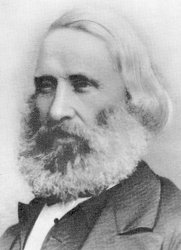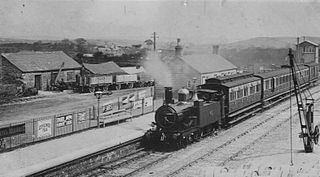
The first Locomotives of the Great Western Railway (GWR) were specified by Isambard Kingdom Brunel but Daniel Gooch was soon appointed as the railway's Locomotive Superintendent. He designed several different 7 ft 1⁄4 in broad gauge types for the growing railway, such as the Firefly and later Iron Duke Class 2-2-2s. In 1864 Gooch was succeeded by Joseph Armstrong who brought his standard gauge experience to the workshops at Swindon. To replace some of the earlier locomotives, he put broad gauge wheels on his standard gauge locomotives and from this time on all locomotives were given numbers, including the broad gauge ones that had previously carried just names.

The Great Western Railway (GWR) 2301 Class or Dean Goods Class is a class of British 0-6-0 steam locomotives.
The Great Western Railway (GWR) 3600 Class was a class of 2-4-2T side tank steam locomotive, designed by William Dean and built at Swindon in three lots in 1900-1903:

Joseph Armstrong was an English locomotive engineer and the second locomotive superintendent of the Great Western Railway. His younger brother George and one of his sons also became outstanding engineers in the employment of the GWR.
The GWR 2201 Class was a class of 4 ft 8 1⁄2 instandard gauge 2-4-0 steam locomotives built at Swindon Works under the aegis of William Dean for express passenger service on the Great Western Railway. Built in 1881-2, they were numbered 2201-2220.
The GWR 378 Class was a class of 30 standard-gauge 2-2-2 steam locomotives on the Great Western Railway in Britain. They were introduced in 1866, and the class remained intact until 1898. Several were altered to the 0-6-0 wheel arrangement, and the last was withdrawn from service in 1920.
The Daniel Gooch standard gauge locomotives comprise several classes of locomotives designed by Daniel Gooch, Superintendent of Locomotive Engines for the Great Western Railway (GWR) from 1837 to 1864.
The Queen Class was Joseph Armstrong's last class of 2-2-2 express engine for the Great Western Railway, larger than the Sir Daniel Class of about a decade earlier. They worked express trains for almost 30 years, and were in effect the predecessors of the larger Singles of William Dean.
The 927 Class or Coal Goods was series of 20 0-6-0 freight steam locomotives designed by Joseph Armstrong for the Great Western Railway, and built at Swindon Works in 1874. They were numbered in the series 927-946.
Between 1854 when the Shrewsbury and Chester and Shrewsbury and Birmingham Railways were absorbed by the Great Western Railway, and 1864 when he moved south to Swindon Works, Joseph Armstrong occupied the post of the GWR's Locomotive Superintendent, Northern Division, at Wolverhampton Works. For ten years the task of providing new locomotives for the GWR's newly acquired standard gauge lines fell jointly to Armstrong and to his superior Daniel Gooch, the railway's principal Locomotive Superintendent who was based at Paddington.

The GWR 481 Class was a class of 20 2-4-0 mixed-traffic steam locomotives designed for the Great Western Railway by Joseph Armstrong and built at Swindon Works in 1869. They were similar in size to the 439 Class but differed in appearance, thanks to the flowing lines of their outside frames.
The 806 Class was Joseph Armstrong's last design of 2-4-0 mixed-traffic locomotives for the Great Western Railway, built at Swindon Works in 1873. A further 20 locomotives were added by Armstrong's successor William Dean in 1881-2; numbered 2201-2220, these had modern domeless boilers. The class had a similar appearance to the 717 Class but had driving wheels 6 in (152 mm) larger.
The GWR 56 Class were 2-4-0 tender locomotives designed for the Great Western Railway by Joseph Armstrong and built at Swindon Works in 1871-2.

The GWR 455 Class, also called the "Metropolitan" or "Metro" Tanks, was a series of 140 2-4-0 tank locomotives built for the Great Western Railway, originally for their London suburban services, including running on the underground section of the Metropolitan Railway, the source of their nickname. Later on the class was seen on many other parts of the GWR system. Sixty "Metro" Tanks were built, from 1868 onwards, during the lifetime of their designer, Joseph Armstrong. His successor William Dean regarded the class so highly that he would add a further 80, the final 20 examples appearing as late as 1899. The "Metros" were all built at Swindon Works, in nine lots of ten or 20 engines each.
The 157 Class of 2-2-2 steam locomotives designed in 1878-9 by William Dean was originally regarded as a reconstruction or renewal of Joseph Armstrong's own 157 Class of 1862. But, as was often the case, these Dean engines were new, and had more in common with Armstrong's more recent, and larger, Queen Class, than with the original 157s. The latter had themselves been rebuilds of engines originally built by Sharp, Stewart & Co., which was probably the source of the enduring nickname Sharpies for the new engines. They were also known as Cobhams, after the name carried by No. 162 throughout its life. No. 158 later carried the name Worcester and No. 163 may have been named Beaufort, though this seems uncertain.
The 69 Class designed by William Dean for the Great Western Railway consisted of eight 2-4-0 tender locomotives, constructed at Swindon Works in 1895-7. Nominally they were renewals of eight engines of the 2-2-2 wheel arrangement that carried the same numbers, these themselves having been renewals by George Armstrong at Wolverhampton of 2-2-2s designed by Daniel Gooch as long ago as 1855.
The 2361 Class is a class of steam locomotives of the Great Western Railway. There were twenty 2361s, numbered 2361-2380 and built at Swindon Railway Works at Lot 67 in 1885/6. They were part of an unusual standardisation scheme whereby William Dean designed four double-framed classes with similar boilers but different wheel arrangements, the others being the 1661, 3201 and 3501.
The 3001 Class as constructed by William Dean at the Swindon Works of the Great Western Railway in 1891-2 was the culmination of the tradition of GWR 2-2-2 locomotives that had begun with Gooch's North Star over 50 years earlier. The 3001s, which had 7 ft 9 in (2.362 m) driving wheels, were built in two batches:
The 3201 or Stella Class was a class of standard gauge 2-4-0 steam locomotive, designed by William Dean and built at Swindon Works for the Great Western Railway in 1884 and 1885.
The 3206 or Barnum Class consisted of 20 locomotives built at Swindon Works for the Great Western Railway in 1889, and was William Dean's most successful 2-4-0 design. Numbered 3206-3225, they were the last GWR locos built at Swindon with "sandwich" frames.




